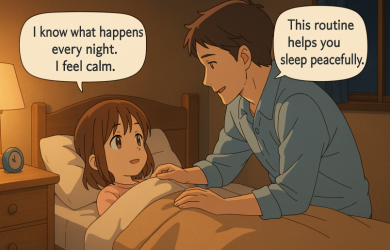Disorganized Attachment Style in Children: Signs, Roots & Therapy

Unlock Daily 30-Sec Tips for a Happier Relationship
👉 Subscribe FREEKey Takeaways
Marriage.com AI Quick Summary
In the world of growing up, about 15% of kids in low psychosocial risk face something tough called disorganized attachment style.
This happens when kids are really scared of getting close to people, even their own families. It’s like they want to be close but are also afraid of it at the same time.
This fear of getting attached can make things confusing for them. They might act in ways that don’t make sense, like being scared or unsure around people who are supposed to make them feel safe.
This whole issue starts when kids don’t get the right kind of care and support they need.
Understanding what this is all about is really important. It helps us see why some kids act the way they do and shows us ways we can help make things better for them, making sure they feel loved and secure.
What is a disorganized attachment style in a child?
A disorganized attachment style in a child is a pattern of behavior where a child shows inconsistent and confused responses toward their caregiver. This often arises from a fear of attachment, also known as disorganized attachment.
Children with this attachment style may simultaneously seek comfort and resist it, displaying a mix of avoidance and anxiety.
Research indicates that disorganized attachment is linked to early experiences of trauma or highly unpredictable caregiving.
According to a study published in the “Journal of Child Psychology and Psychiatry,” children with disorganized attachment are at a higher risk for developing emotional and social issues later in life.
This highlights the importance of early intervention and support for these children and their families to foster secure attachments.
How do disorganized attachment styles develop in early childhood?
Disorganized attachment styles in early childhood often develop from inconsistent or frightening caregiving experiences. This fear of attachment is called disorganized attachment, where children are left confused about whether their caregiver is a source of safety or fear.
For instance, a child who receives love and comfort from a parent one moment but faces harsh rejection or unpredictable behavior the next may struggle to understand how to respond.
Maggie Martinez, LCSW, notes,
Another example of where disorganized attachment might stem from is if a child is consistently given food and diaper changes but then all of a sudden is no longer having their food or hygiene needs met.
Similarly, a child exposed to a caregiver’s frightening behaviors, such as yelling or being emotionally unavailable, can lead to the child feeling unsafe and unsure about seeking comfort.
These scenarios create a chaotic emotional environment, preventing the child from developing a consistent and secure way of relating to their caregivers, thus fostering a disorganized attachment style.
What causes disorganized attachment in children?
Disorganized attachment in children stems from a complex interplay of factors that disrupt their sense of safety and security in relationships. This leads to causes of personal disorganization in attachment style, where children exhibit unpredictable and often contradictory behaviors towards caregivers. Key factors include:
- Inconsistent caregiving: When caregivers alternate unpredictably between warmth and neglect or hostility, children cannot develop a stable expectation of support, leading to confusion and fear.
- Trauma or abuse: Exposure to traumatic events, including physical, emotional, or sexual abuse, undermines a child’s trust in caregivers and can result in a disorganized attachment style.
- Parental mental health issues: Parents struggling with their own mental health issues may be unable to provide consistent, responsive care, contributing to a child’s insecurity and confusion about emotional connections.
- Substance abuse in the family: Substance abuse can lead to erratic behavior from caregivers, making it difficult for children to form a coherent strategy for seeking comfort and support.
- Parental grief or unresolved trauma: Parents dealing with unresolved grief or trauma may be emotionally unavailable or unpredictably responsive, preventing the development of a secure attachment.
7 serious signs of disorganized attachment
Disorganized attachment in children manifests through behaviors that signal deep-seated confusion and insecurity about their relationship with caregivers.
This form of attachment, marked by a lack of coherent strategy for seeking comfort and protection, can have profound implications on a child’s emotional and social development.
Recognizing the signs of disorganized attachment style in children is crucial for early intervention and support.
1. Contradictory behaviors toward caregivers
Children with disorganized attachment often exhibit behaviors that are contradictory, such as seeking closeness with a caregiver but then suddenly withdrawing or reacting with aggression. This reflects their internal conflict and confusion about whether the caregiver is a source of safety or fear.
Maggie Martinez, LCSW, states,
When a child is giving mixed signals and behavior, it is important to recognize that and see support.
2. Freezing or stilling
A hallmark sign of disorganized attachment style signs is the child’s sudden freezing, stilling, or immobilized behavior in the presence of a caregiver. This indicates a temporary breakdown in the child’s strategy for dealing with stress or threat.
3. Dazed or confused expressions
Children may display dazed, confused, or disoriented expressions when interacting with caregivers. This can suggest an overwhelmed emotional state where the child is unable to process their feelings or the caregiver’s actions effectively.
4. Frightened or frightening behavior
Signs of disorganized attachment style in children also include displays of inexplicable fear or the exhibition of frightening behavior towards the caregiver. This can stem from past experiences of trauma or unpredictable caregiver behavior.
5. Lack of a clear attachment strategy
Unlike securely attached children who consistently seek comfort from their caregivers, those with a disorganized attachment show no coherent strategy for achieving security and comfort, often displaying a mix of attachment behaviors that are erratic and unpredictable.
6. Difficulty being comforted
Another significant sign is the child’s apparent difficulty in being comforted by the caregiver following distressing episodes. This difficulty indicates a deep uncertainty about the reliability of the caregiver as a source of comfort.
7. Exhibiting caregiving or role-reversed behaviors
In some cases, children may take on a caregiving role towards the caregiver or siblings, a behavior that suggests an inversion of the natural child-caregiver dynamic. This can be a coping strategy stemming from the child’s need to make sense of their disorganized attachment experience.
Learn more about the connection between neglect in childhood and disorganized attachment in this video:
How to deal with a disorganized attachment style in Child: 13 helpful ways
Dealing with a disorganized attachment style in a child requires patience, understanding, and targeted strategies to foster security and trust. This approach helps mitigate the confusion and fear associated with their attachment experiences, guiding them toward healthier relationships.
Here are thirteen helpful ways to support a child with a disorganized attachment style:
1. Establish a consistent routine
A predictable daily routine provides a sense of security and stability, helping the child to feel more secure and less anxious about unexpected changes or caregiver responses.
2. Offer predictable responses
Ensure your reactions to the child’s behaviors are consistent and predictable. This consistency helps the child to develop an understanding of cause and effect within relationships, fostering a sense of safety.
3. Engage in attuned communication
Pay close attention to the child’s verbal and non-verbal cues. Responsive and attuned communication demonstrates your awareness of their needs and feelings, building trust.
4. Create a safe environment
Ensure the child’s physical and emotional environment is safe and nurturing. A safe environment is foundational for the child to explore relationships and express themselves without fear.
5. Encourage emotional expression
Support the child in identifying and expressing their emotions in healthy ways. Validating their feelings reinforces that it’s safe to share emotions with caregivers.
Maggie Martinez, LCSW, highlights,
As a caregiver, it is important to model emotional expressions so that the child can see how to do it for themselves.
6. Foster secure attachments through play
Engage in regular, predictable play sessions. Play is a crucial way for children to learn about relationships and self-regulation and to form secure attachments.
7. Model appropriate behavior
Children learn by example. Modeling calm, controlled, and caring behavior teaches them how to manage their emotions and interactions with others.
8. Seek professional support
A therapist specializing in attachment issues can provide targeted strategies for both the child and caregiver, facilitating the development of a more organized attachment style.
9. Use calming techniques
Teach the child calming techniques such as deep breathing or mindfulness. These tools can help them manage anxiety and feel more in control.
10. Promote social interactions
Encourage positive social interactions with peers and adults. Gradual, supported exposure to social settings can enhance the child’s relationship skills and confidence.
11. Be patient and persistent
Understanding and addressing disorganized attachment takes time. Patience and persistence are crucial in supporting the child through their developmental journey.
12. Reflect on your attachment style
Caregivers should reflect on their attachment styles, as their own attachment experiences can influence their interactions with the child. Awareness can lead to more empathetic and supportive caregiving.
13. Celebrate progress
Acknowledge and celebrate the child’s progress, no matter how small. Positive reinforcement encourages the child and reinforces the value of secure attachments.
FAQs
Understanding disorganized attachment in children and adults can shed light on complex behaviors and relationship dynamics. Let’s explore some frequently asked questions to gain clarity on this attachment style.
-
What are the behaviors of disorganized attachment?
Behaviors of disorganized attachment include inconsistency, such as seeking closeness then pulling away, showing fear without a clear reason, freezing or dazing, and displaying contradictory signals like reaching out but not looking at the caregiver.
-
What does disorganized attachment look like in a relationship?
In relationships, disorganized attachment may manifest as fluctuating between needing closeness and pushing away, difficulty trusting partners, showing intense fear of abandonment, and sometimes behaving in confusing or contradictory ways towards loved ones.
-
Which attachment style is hardest to treat?
Disorganized attachment is often considered the hardest to treat due to its roots in early trauma and the complexity of its symptoms. It requires careful, trauma-informed therapeutic approaches to address the underlying issues effectively.
-
Can you have disorganized attachment without trauma?
While disorganized attachment is strongly linked to early trauma, it can also develop in environments where caregivers are highly inconsistent, emotionally unavailable, or unable to meet the child’s emotional needs, even in the absence of overt trauma.
A path toward healing
Understanding the signs and causes of disorganized attachment in children is the first step toward fostering healing and secure relationships.
By recognizing the underlying issues and employing targeted strategies to deal with them, caregivers can offer children a foundation for healthier emotional connections.
Looking ahead, with increased awareness and supportive interventions, we can envision a future where children overcome the challenges of disorganized attachment, leading to more secure, confident, and fulfilling lives.
The journey may be complex, but the prospects for growth and healing hold endless possibilities.
 Tips
Tips
Write your tip or submit a video tip
All tips are reviewed before the publishing.
Share this article on
Want to have a happier, healthier marriage?
If you feel disconnected or frustrated about the state of your marriage but want to avoid separation and/or divorce, the marriage.com course meant for married couples is an excellent resource to help you overcome the most challenging aspects of being married.
Recent Articles
Related Quizzes
Unlock Daily 30-Sec Tips for a Happier, Healthier Relationship
👉 Subscribe FREE on YouTube We'd love your feedback!
We'd love your feedback!
 Expert Q&A
Expert Q&A
Ask your question related to this topic & get the support you deserve from experts.





















 Thanks for your feedback!
Thanks for your feedback!